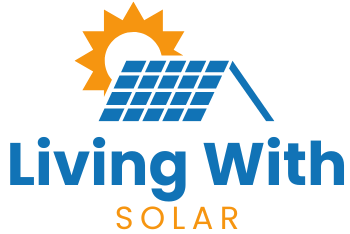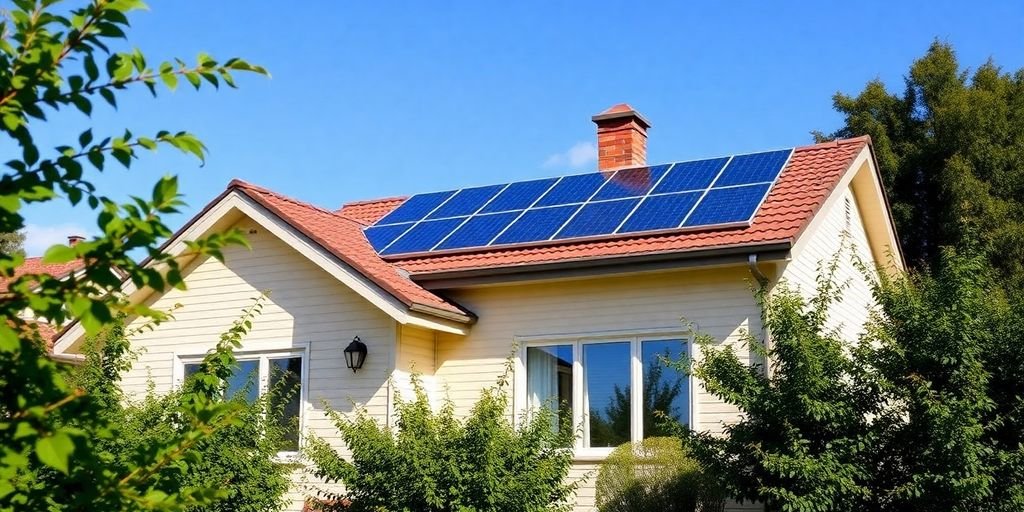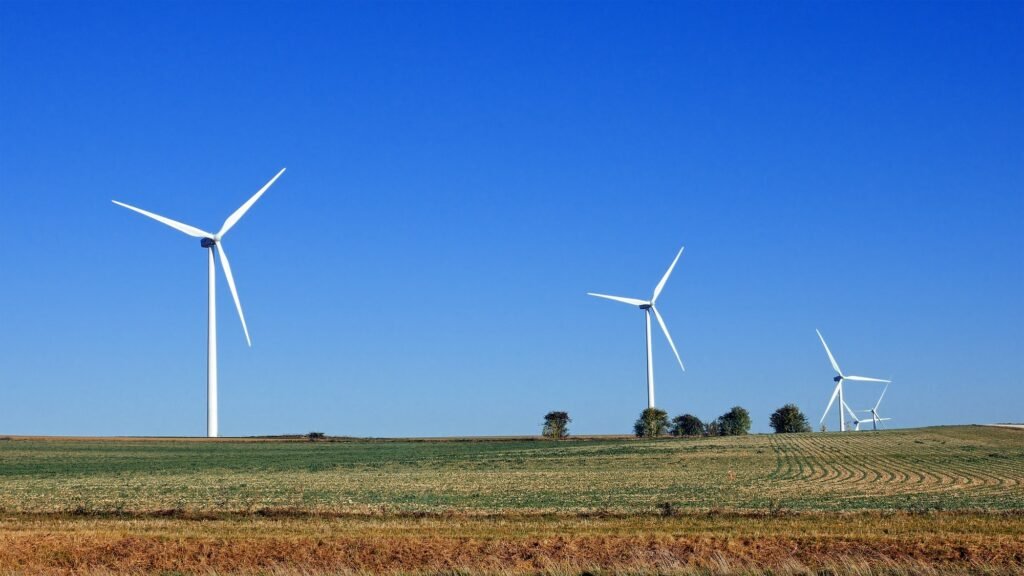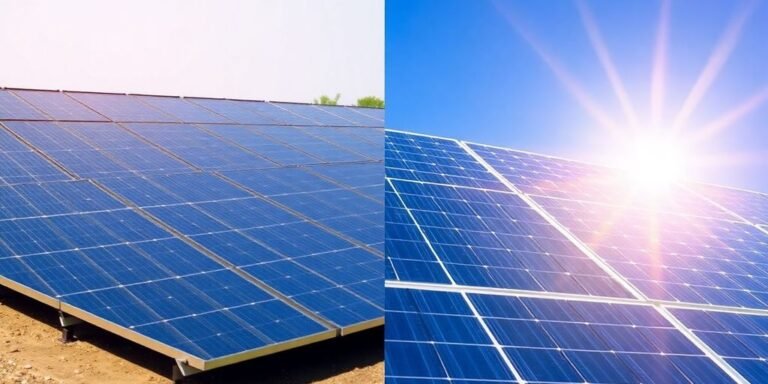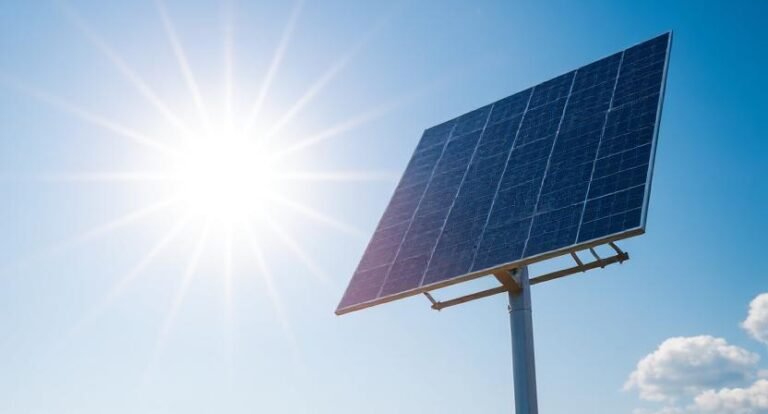Choosing the right solar panels for your home can seem overwhelming, but it doesn’t have to be. With the right information, you can make a smart decision that fits your needs and budget. This guide will help you understand what to look for in solar panels, considering factors like your roof’s characteristics, climate, and the types of panels available. Let’s break it down so you can find the best solar panel for home use that works for you.
Key Takeaways
- Evaluate your roof’s size and shading to determine the best panel fit.
- Consider your local climate when selecting solar panel types.
- Compare the efficiency and cost of different solar panels.
- Look into long-term value and warranties when making your choice.
- Find a qualified installer to ensure proper setup and performance.
What are solar Panels?
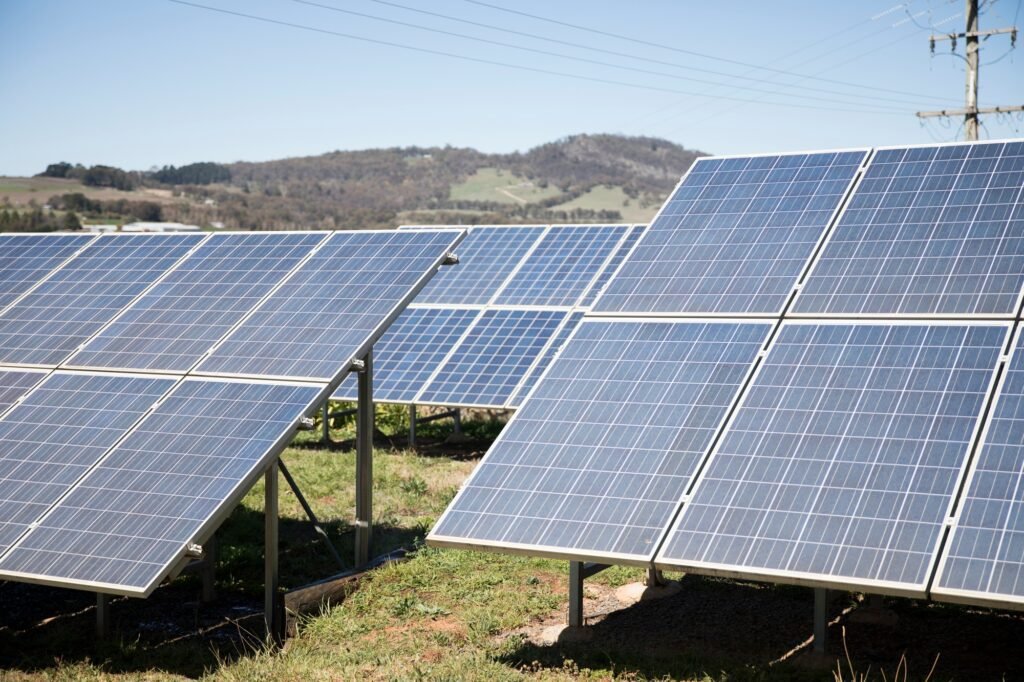
Okay, so what are solar panels anyway? I think most people have a general idea, but let’s get into the specifics.
They’re devices that convert sunlight into electricity. It’s not magic, but it sure feels like it sometimes! You stick something in the sun, and boom, you’re making your own power. Pretty cool, right?
They’re made of photovoltaic cells. These cells absorb sunlight, and the energy from the sun knocks electrons loose, creating an electrical current. This current is then converted into a form that your home can use. It’s a pretty neat process, and it’s getting more efficient all the time.
I’ve been looking into solar energy costs lately, and it’s amazing how much the price has come down over the years. Plus, with incentives and the potential to save on my electricity bill, it’s starting to look like a really smart investment.
Here’s a quick rundown of why I’m considering solar panels:
- Save Money: Generate your power and reduce your reliance on the grid.
- Go Green: Reduce your carbon footprint and help the environment.
- Increase Home Value: Solar panels can increase the value of your home.
And it’s not just the panels themselves that are evolving. I’ve been reading about smart panels that use monitoring systems to optimize energy production. Plus, there are portable solar panels that don’t require installation. It’s a whole new world of solar technology out there!
Your Roof’s Size, Shape, and Shading
When figuring out which solar panels are best, I always start by looking at the roof. It’s the foundation of the whole project, literally! The size, shape, and any shading issues can really dictate what kind of panels will work best and how much power I can expect to generate. It’s not just about slapping panels up there; it’s about maximizing efficiency within the constraints of my existing roof.
Shading Reduces Performance – What to Do
Shade is the enemy! Even a little bit of shade can seriously cut down on how much electricity my panels produce. It’s like putting a kink in a hose – the whole system suffers. I need to be realistic about how much sun my roof actually gets throughout the day. If there are trees or nearby buildings casting shadows, I have a few options:
- Trim the trees (if they’re mine, of course!).
- Consider micro-inverters or power optimizers. These let each panel operate independently, so if one is shaded, it doesn’t drag down the performance of the others. This is a great way to improve solar panel dimensions.
- Think about where the shading occurs. Maybe I can position the panels in the least shaded areas.
Dealing with shading can be a pain, but it’s worth it to get the most out of my solar investment. I’d rather spend a little extra upfront to mitigate shading issues than lose out on power generation for years to come.
Complex Roof Shapes? Go with Flexible or Compact Panels
Not all roofs are created equal. If I have a roof with lots of dormers, skylights, or other obstructions, it can be tricky to fit standard-sized, rectangular panels. That’s where flexible or compact panels come in handy. They offer more versatility in terms of placement. Here’s a quick comparison:
| Feature | Standard Panels | Flexible Panels | Compact Panels |
|---|---|---|---|
| Size | Larger | Smaller | Smaller |
| Shape | Rectangular | Variable | Rectangular |
| Installation | More complex | Easier | Easier |
| Best For | Simple roofs | Complex roofs | Limited space |
With a complicated roof, I might need to get creative with panel placement. It might mean using a mix of panel types to maximize the available surface area. It’s like a puzzle, but the reward is clean, renewable energy. I’ll need to consider the best roof for solar panels.
Your Region and Climate
Where I live plays a big role in picking out the right solar panels. It’s not just about sunshine; it’s about the whole weather package.
Hot & Sunny Areas – Watch the Temperature Coefficient
If you’re in a place that’s scorching hot most of the time, like Arizona, you need to pay attention to something called the temperature coefficient. This tells you how well a solar panel performs when it gets hot.
Solar panels become less efficient as their temperature rises. A lower temperature coefficient means the panel will maintain its efficiency better in the heat. It’s a small detail, but it can make a big difference in how much power you get from your solar panels on those blazing summer days.
Cold or Cloudy Regions – Choose Panels with Strong Low-Light Performance
On the flip side, if you’re in a place that’s often cloudy or cold, like Seattle, you’ll want to look for panels that are good at capturing sunlight even in low-light conditions.
Some panels are specifically designed to perform well when the sun isn’t at its brightest. These panels can make a big difference in your overall energy production, especially during those long, gray winters. It’s all about maximizing the available light.
Wind, Snow, and Dirt – Look for Durable, Dual-Glass Panels
And then there’s the issue of weather. If you live in an area with high winds, heavy snow, or lots of dust and dirt, you’ll want to make sure your panels are durable enough to withstand those conditions. Dual-glass panels are a good option because they’re more resistant to physical damage and degradation.
They’re built to last, even when the weather is trying its best to beat them up. I’d rather pay a bit more upfront for something that’s going to hold up over time. Plus, consider the solar calculator to estimate energy production in your specific climate.
“Living in a place with harsh weather means I have to think seriously about the long-term durability of my solar panels. It’s not just about finding the cheapest option — it’s about investing in something that will last and perform well for years, no matter what Mother Nature throws at it. That’s why I’m leaning toward dual-glass panels. They feel like a smart, reliable choice for my peace of mind.”
What Can Impact Your Solar Panels’ Performance?
As someone who’s been researching solar panels, I’ve learned that getting the right panels is only half the battle. Several factors can significantly impact how well your solar panels perform after they’re installed.
It’s not just about slapping them on the roof and forgetting about them; you need to consider the environment and how it interacts with your system.
Panel Orientation & Tilt
The direction your panels face and their angle relative to the sun are critical for maximizing energy production. If I had to pick one thing to get right, it would be this.
A south-facing roof is generally considered ideal in the Northern Hemisphere, as it receives the most direct sunlight throughout the day. However, the optimal tilt angle depends on your latitude.
For example, a tilt angle close to your latitude is often recommended for year-round performance. If you live in an area with distinct seasons, you might adjust the tilt twice a year to optimize for summer and winter sun angles. Getting this right can really boost your solar panel installation.
Here’s a quick rundown of things to consider:
- Orientation: South-facing is best, but southeast or southwest can also work well.
- Tilt Angle: Match your latitude for year-round performance, or adjust seasonally.
- Shading: Avoid placing panels where they’ll be shaded by trees or buildings. Even partial shading can significantly reduce output.
Understanding these factors will help me ensure my solar panels are positioned for peak performance. It’s all about making the most of the available sunlight and optimizing the system for my specific location. I’ll be paying close attention to these details when I finally get my system installed. I’ll also be sure to choose monocrystalline panels for better efficiency.
Compare Solar Panel Types
Okay, so now we get to the fun part: figuring out what kind of solar panel is right for you. There are a few main types, and each has its own set of pros and cons. It’s not a one-size-fits-all situation, so let’s break it down.
Monocrystalline – Most Efficient, Ideal for Limited Space
If you’re tight on space, monocrystalline panels are probably the way to go. They’re the most efficient type of solar panel out there, which means you can get more power from a smaller area.
They’re made from a single crystal of silicon, which gives them that characteristic black color. They tend to be a bit pricier, but if roof space is at a premium, it’s worth the investment.
I’ve seen some pretty impressive setups using these, especially in urban areas where every square foot counts. If you are looking for solar panel systems, this might be the right choice.
- Higher efficiency (17-22%)
- Sleek, uniform look
- More expensive
Polycrystalline – Lower Cost, More Space Needed
Polycrystalline panels are a budget-friendly option. They’re made from multiple silicon crystals melted together, which gives them a slightly blue, speckled appearance.
They’re not quite as efficient as monocrystalline panels, so you’ll need more space to generate the same amount of power.
But if you’ve got a large roof and you’re trying to save some money upfront, they’re a solid choice. I’ve seen people use these to great effect on larger, rural properties. They are a great way to get photovoltaic panels installed without breaking the bank.
- Lower cost per watt
- Slightly lower efficiency (15-17%)
- Require more space
I think it’s important to consider the long-term value here. While polycrystalline panels might save you money initially, the slightly lower efficiency could mean you need more panels to meet your energy needs. This could impact your roof space and overall system cost. So, it’s a balancing act between upfront savings and long-term performance.
Compare Key Panel Specs That Matter

Okay, so you’re getting serious about solar. Good! Now it’s time to get into the nitty-gritty of panel specifications. It can seem overwhelming, but trust me, understanding these specs will help you make a smart choice. I’m going to break down the key things I looked at when I was choosing my panels.
First off, let’s talk about power output. This is usually measured in watts (W). It tells you how much electricity a panel can produce under ideal conditions. Higher wattage generally means more electricity, but it’s not the only thing to consider.
Then there’s efficiency. This is the percentage of sunlight that a panel can convert into electricity. A more efficient panel will produce more power from the same amount of space. This is super important if you have limited roof space. For example, efficient solar panels are a great choice if you don’t have a lot of space.
Here’s a quick rundown of other specs I paid attention to:
- Voltage: Make sure the panel’s voltage is compatible with your inverter and other system components.
- Temperature Coefficient: This tells you how much the panel’s performance degrades in hot weather. A lower number is better.
- Warranty: Check the warranty terms carefully. A longer warranty usually indicates a higher-quality panel.
I found that reading customer reviews and comparing datasheets from different manufacturers was really helpful. Don’t just rely on the sales pitch; do your own research!
Finally, don’t forget about the physical dimensions and weight of the panels. You need to make sure they’ll fit on your roof and that your roof can handle the load. It’s a lot to think about, but it’s worth it to get the right panels for your home.
Consider Cost vs Long-Term Value
Okay, so you’re staring at price tags, and it’s tempting to just grab the cheapest solar panels you can find. I get it. But trust me, it’s worth digging a little deeper. Think about it like this: are you buying a cheap umbrella that’ll fall apart in the first storm, or a sturdy one that’ll last for years?
When It’s Worth Paying More
Sometimes, spending a bit more upfront can save you a ton of money (and headaches) down the road. Here’s what I’ve learned:
- Higher Efficiency: Panels with better efficiency ratings generate more power from the same amount of sunlight. This is especially important if you have limited roof space. I’ve seen people try to save a few bucks on less efficient panels, only to realize they need more panels to meet their energy needs, which ends up costing them more in the long run.
- Durability and Warranty: A solid warranty is like insurance for your solar investment. It protects you against defects and performance issues. I always check the warranty terms carefully. A longer warranty often indicates that the manufacturer has confidence in their product’s longevity. Plus, durable panels can withstand harsh weather conditions, reducing the risk of damage and replacement costs.
- Temperature Coefficient: This is a big one that people often overlook. The temperature coefficient tells you how well a panel performs in hot weather. Panels get hot, especially in the summer, and their efficiency can drop. A lower temperature coefficient means the panel’s performance is less affected by heat. If you live in a hot climate, paying more for panels with a better temperature coefficient can make a significant difference in your energy production.
I always try to think about the total cost of ownership, not just the initial price. This includes factors like energy production, maintenance, and lifespan. Sometimes, the more expensive option is actually the better value in the long run. It’s like buying a car – you might save money upfront with a cheaper model, but if it breaks down constantly and guzzles gas, you’ll end up paying more over time.
Here’s a simplified example of how to calculate your solar system ROI:
Lifetime Utility Costs – Lifetime Cost of Solar = Solar System ROI
If what you’d normally pay the electric company over the next 25-30 years is more than what you paid for the system, you’re in the green!
Take Advantage of Solar Incentives
Going solar isn’t just about saving money on your electricity bill; it’s also about tapping into a range of incentives that can significantly reduce the upfront cost. I’ve found that understanding these incentives is key to making solar power truly affordable.
One of the biggest incentives is the federal solar tax credit. Currently, it allows you to deduct 30% of the cost of your solar panel system from your federal taxes. This includes not only the panels themselves but also installation costs. It’s a substantial savings that can make a real difference in your overall investment.
Beyond the federal tax credit, many states and local governments offer additional incentives. These can include state tax credits, rebates, and even grants.
The availability and value of these incentives vary widely, so it’s worth doing some research to see what’s available in your area. A good place to start is the DSIRE (Database of State Incentives for Renewables & Efficiency) website, which provides a comprehensive list of incentives by state.
Don’t forget to check with your local utility company as well. Many utilities offer rebates or other incentives to encourage customers to switch to solar power. These programs can be a great way to further reduce the cost of your system.
It’s also important to consider solar financing options. While paying cash for your system will maximize your long-term savings, financing can make solar more accessible in the short term. Just be sure to shop around for the best interest rates and terms.
Here’s a quick rundown of common solar incentives:
- Federal Tax Credit: 30% of the system cost.
- State Tax Credits: Varies by state, but can be a significant percentage of the system cost.
- Rebates: Offered by states, local governments, and utilities.
- Grants: Less common, but can provide substantial upfront funding.
By taking advantage of these incentives, I was able to significantly reduce the cost of my solar panel system and make it a much more attractive investment. It’s definitely worth the effort to explore all the options available to you.
Choose a Reliable Installer

Okay, so you’ve picked out your panels, figured out the best solar companies, and you’re ready to go. But hold on! Don’t underestimate the importance of who actually puts those panels on your roof. A bad installer can turn your solar dream into a solar nightmare. Trust me, I’ve heard the horror stories.
Here’s what I’ve learned about picking a good one:
- Get multiple quotes: Don’t settle for the first installer that gets back to you. Request quotes from at least three reputable companies to compare pricing, service options, and timelines. It’ll help you avoid being overcharged — or worse, undercharged by a low-quality provider.
- Verify credentials and insurance: Always confirm that your installer is licensed, insured, and bonded in your state. Look for certifications like NABCEP (North American Board of Certified Energy Practitioners) — it’s a mark of professionalism and advanced training.
- Check reviews and ask for references: Look beyond the testimonials on their website. Read reviews on trusted platforms like Google, Yelp, or EnergySage. Then ask the company for references — and actually follow up with those past clients to get honest, firsthand feedback.
I think it’s important to remember that the cheapest option isn’t always the best. A reputable installer might cost a bit more upfront, but they’ll likely do a better job and provide better service in the long run. Plus, a good installation can actually improve the performance of your solar panels, saving you money over time.
- Understand the warranty. What does the installer’s warranty cover? How long does it last? Make sure you’re clear on the terms before you sign anything. A solid warranty is a sign that the installer stands behind their work.
- Ask about their experience. How long have they been installing solar panels? How many installations have they completed? An experienced installer is more likely to do the job right.
- Don’t be afraid to ask questions. A good installer should be happy to answer all of your questions and address any concerns you have. If they’re evasive or dismissive, that’s a bad sign.
Choosing the right installer is a big decision, so take your time and do your research. It’s worth it to ensure your solar system is installed correctly and will provide you with clean, affordable energy for years to come. You might even want to check out some solar loan providers to help with the cost.
Wrapping It Up
Choosing the right solar panels for your home doesn’t have to be a headache. Just remember to think about your energy needs, budget, and roof type. Take your time to compare different options and don’t hesitate to ask questions. It’s all about finding a balance between efficiency and cost.
Plus, with the right panels, you can save money on your energy bills and help the environment at the same time. If you’re feeling overwhelmed, reaching out to a solar expert can really help clarify things. In the end, going solar is a big step towards a greener future, so make sure you pick the best fit for your home.
Frequently Asked Questions
What are solar panels?
Solar panels are devices that convert sunlight into electricity. They are made up of many smaller units called solar cells, which capture sunlight and turn it into usable energy for your home.
How do I know if my roof is suitable for solar panels?
The best roofs for solar panels are large, flat, and face south without any shading from trees or buildings. A roof with about 480 square feet of space is ideal for installation.
What types of solar panels are available?
There are three main types of solar panels: monocrystalline, polycrystalline, and thin-film. Monocrystalline panels are the most efficient, while polycrystalline panels are usually cheaper. Thin-film panels are lighter and flexible.
How can I improve the performance of my solar panels?
To boost the efficiency of your solar panels, choose ones with a high-efficiency rating, keep them clean from dirt and debris, and make sure they are installed in sunny areas without shade.
What should I consider when comparing solar panel costs?
When looking at solar panel prices, think about the upfront cost versus long-term savings on your electricity bills. Also, consider the warranties that come with the panels.
Why is it important to hire a good solar panel installer?
A reliable installer ensures your solar panels are set up correctly and safely. They can help you choose the right panels for your roof and make sure everything meets local codes.
